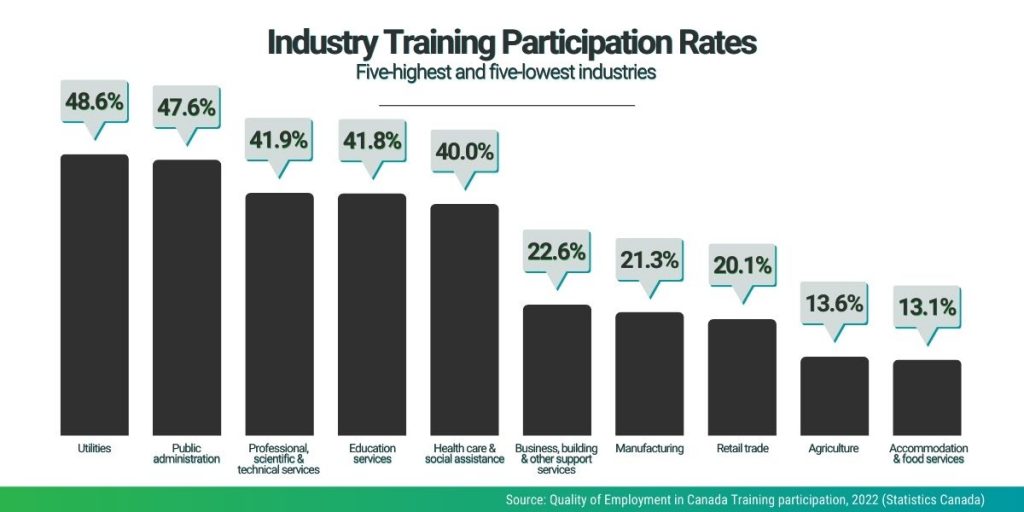
It is widely accepted that continued job-related training is beneficial to an individual’s career development and job satisfaction, as well as a crucial part of a Canadian organization’s growth. Training participation varies amongst organizations due to many factors including the size of the organization, employee tenure, available content, and budget. In addition, training is often a component of human resources and management dialogues about employee development.
Benefits of Training to the Organization:
Common Training Roadblocks:
Over the last decade there have been minimal gains in the amount of money Canadian organizations spent on training per employee (2017 saw an $89 increase over the previous reporting period to an average of $889 per employee) as well as the amount of time dedicated to job-related training. Since 2017 there have only been incremental increases in the overall spending on employees.
Effective spending on employee training is not only about the money and hours spent on training, it’s also about where to invest in training and who to invest in.
To help many organizations overcome their training roadblocks, CIET has developed a number of services that deliver valuable training:
In June 2023, Statistics Canada released findings from a training participation survey conducted over a 12-month period (ending in November 2022). Here’s a snapshot of the findings from the report and what we can learn from them.
Looking at the training participation by sector, we can see that there is nearly a 16% difference in the participation between the public sector and the private sector.

Public sector organizations may have more defined funds and policies in place to ensure ongoing training for employees whereas self-employed workers may be more focused on the job at hand and restricted by time and funds. Regardless, there is clearly an opportunity for organizations in the private sector to increase training opportunities for their employees.
Of course, there are many benefits to encouraging and funding private sector employee training:
“Participation in job-related training offers benefits to both workers and businesses in a context of ongoing societal and technological change. Training helps workers become more employable or provides skills that can help them take on more responsibilities with their current employer. For businesses, training can improve productivity and make employees more confident and motivated in their jobs.” – Statistics Canada
Data related to the size of an organization indicates that those with more workers have a higher rate of training participation. Similarly, this could be attributed to more policies and structures put in place for training in those organizations.

The survey provided a province-by-province percentage of training participation, reporting that Ontario, the largest province, has the smallest percentage of workers in job-related training. Meanwhile, Alberta and Quebec are the top of the class.
Did you know: Many CIET training programs are eligible for provincial assistance programs? In Ontario for instance, under the Save on Energy program banner, the IESO provides generous training incentives for organizations that can cover between 50-75% of training costs. You can find additional incentives by province here.
Based on the survey findings, employers are much more likely to provide training to people with post-secondary education (bachelor’s degree) or higher.

So where does that leave those with academic training below a bachelor’s degree?
Within that level of education, there are certain jobs for which training is important (BAS, maintenance staff, building operators, HVAC technicians, etc.).
As one might assume, the rate of investment in employee training is highly variable across the various economic sectors of activity. Statistics Canada’s Training Participation 2022 report results show Utilities are the leading sector in terms of training participation rates per capita. Not only is training offered to employees, but many companies also offer training to their regional stakeholders and vendors as well.

Coast-to-coast examples of utilities purchasing CIET training for regional stakeholders:
CIET supports the growth of over 2,500 energy efficiency and decarbonization professionals every year. Our courses and certification programs have been carefully designed to help both individuals and organizations develop the most in-demand skills in the industry. Start your training journey today.

|
Training calendar |

Would you like to be trained on a specific topic? Just let us know!
Express my interestSend us an email and we will respond as soon as possible.
